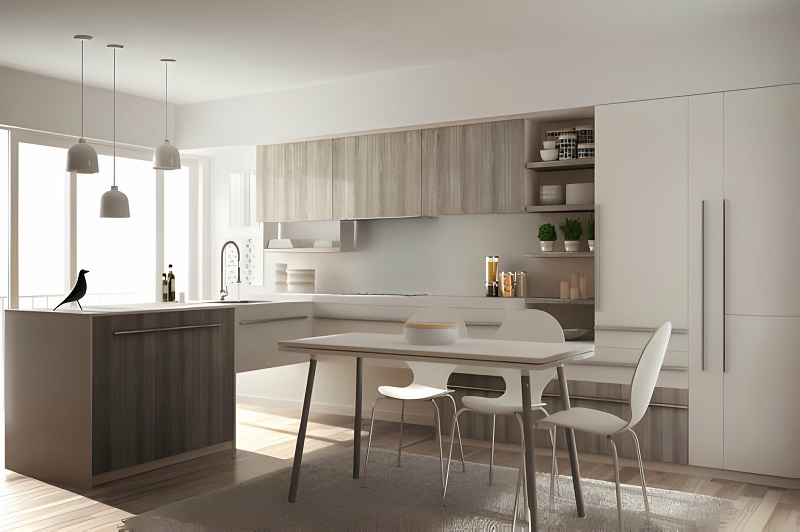Great Eco-Friendly Tips and Tricks for Your New Kitchen
First, let me ask you something, who doesn't enjoy a freshly brewed cup of coffee in an up-to-date, chic kitchen in the early morning light? Or how about the joy of hosting a spontaneous dinner party around a kitchen island meticulously designed to facilitate conversation, movement, and the casual dance of culinary prowess? But what if I tell you that the kitchen, the very heart of our homes, can also be a haven for sustainable living? Does it sound too good to be true? Well, it's not.
In this post, we will delve deep into eco-friendly practices and products that aim to minimize our impact on the environment, helping you contribute to a greener planet. Imagine preparing your meals and hosting those cherished gatherings in a kitchen designed not only for efficiency and aesthetics, but also with the health of the planet in mind.
Creating an eco-friendly kitchen isn't just about your choice of appliances or surface materials. It's a way of living that respects our environment through conscious, sustainable choices. Are you ready to explore how you can turn your kitchen into an eco-friendly paradise? Let's get started!
 |
Building the Basics: Making Eco-Friendly Choices
The concept of sustainability doesn't stop at recycling or reducing waste. It weaves its way into every area of our lives, including the very structures we call home. It's all about making a conscious choice—reusing instead of disposing, reducing energy consumption, and choosing sustainably sourced materials. This section will outline practical tips that can guide your eco-friendly kitchen journey.
From material selections such as bamboo (an incredibly renewable resource) for your cabinets, linoleum or cork for your flooring, to recycled glass countertops, there's an abundance of options that respect our planet. You can opt for energy-efficient appliances specifically designed to reduce energy consumption or go for vintage appliances that add style with sustainability.
Moreover, pay attention to other elements like paint, adhesive, and sealants. Opt for low or no-VOC (Volatile Organic Compounds) products as they not only help the environment but also maintain the indoor air quality. Now, isn't that a win-win?
The Zero Waste Kitchen: Emitting Less for Good
Waste reduction is a key factor in creating an eco-friendly kitchen. Did you know Australians generate approximately 67 million tonnes of waste annually? Imagine the impact if we can reduce just a fraction of that. This section will provide some ideas on how to do just that.
It starts from simple habits like shopping with reusable bags, purchasing items in bulk, or composting food waste. Invest in durable kitchen equipment and prefer products with minimal packaging.
Another tactic is creating a simple system to segregate waste into recyclables and non-recyclables. Lastly, consider installing a kitchen composting system. Not only will it minimize your landfill contribution, but it will also provide nutrient-rich compost for your home garden.
The Proper Lighting: Balancing Practicality with Sustainability
Good lighting can make or break a kitchen’s ambiance. But how can we be sustainable about this? Well, LED light bulbs are an excellent option.
They are energy efficient and have a longer lifespan compared with conventional bulbs. Also, consider designing your kitchen to maximize natural light. This will not only reduce your dependence on artificial light but also create an inviting space filled with warmth and vitality.
The Water Factor: Conserving Our Most Vital Resource
Water is an indispensable part of any kitchen, but it’s also one of the resources we should conserve the most. Installing water-saving faucets and fixtures is a good start.
Investing in a dishwasher may also be a wise choice - modern energy-efficient models can use less water than handwashing. Don't forget revising your personal habits - do you let the faucet run while scrubbing dishes? With small changes, significant improvements can be made.
 |
The Life-After-Kitchen: Planning for the End of Life
In designing an eco-friendly kitchen, think beyond the present. Sustainable living also means considering what happens to your old appliances, furniture, or cabinetry. Can they be repurposed, recycled, or composted?
Choose sturdy, timeless pieces that will stand the test of time, rather than disposable items that need to be replaced regularly. And if it’s time to bid them goodbye, look into responsible disposal or recycling options.
Conclusion: Embracing Your Sustainable Kitchen Journey
Embarking on a journey to create a sustainable kitchen is a conscious decision that ripples out to impact not just our immediate environment but the world at large. This pursuit is not exclusive to a select few — it's a inclusive path open to anyone willing to make mindful choices.
What’s more, opting for an eco-friendly kitchen does not mean sacrificing aesthetics or functionality. On the contrary, it allows us to create spaces closest to nature, radiating calm and balance while respecting our planet. So, are you ready to make that delicious lasagna in your eco-friendly kitchen?
Remember, every little bit counts. Continuous small steps can gradually build towards significant change. Let's start today, in our own kitchens, paving the path towards sustainability and a greener earth.








No comments